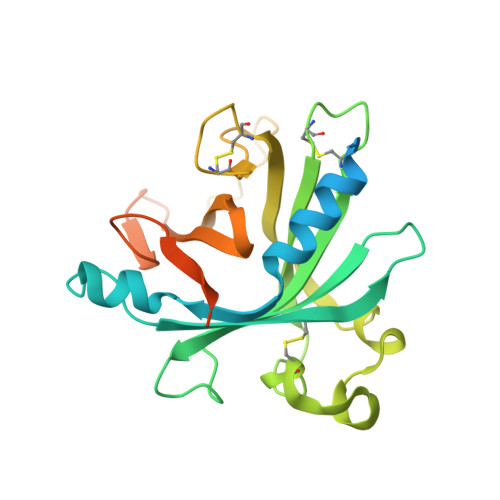The Arabidopsis CRUMPLED LEAF protein, a homolog of the cyanobacterial bilin lyase, retains the bilin-binding pocket for a yet unknown function.
Wang, F., Fang, J., Guan, K., Luo, S., Dogra, V., Li, B., Ma, D., Zhao, X., Lee, K.P., Sun, P., Xin, J., Liu, T., Xing, W., Kim, C.(2020) Plant J 104: 964-978
- PubMed: 32860438
- DOI: https://doi.org/10.1111/tpj.14974
- Primary Citation of Related Structures:
6LIX, 6LIY - PubMed Abstract:
The photosynthetic bacterial phycobiliprotein lyases, also called CpcT lyases, catalyze the biogenesis of phycobilisome, a light-harvesting antenna complex, through the covalent attachment of chromophores to the antenna proteins. The Arabidopsis CRUMPLED LEAF (CRL) protein is a homolog of the cyanobacterial CpcT lyase. Loss of CRL leads to multiple lesions, including localized foliar cell death, constitutive expression of stress-related nuclear genes, abnormal cell cycle, and impaired plastid division. Notwithstanding the apparent phenotypes, the function of CRL still remains elusive. To gain insight into the function of CRL, we examined whether CRL still retains the capacity to bind with the bacterial chromophore phycocyanobilin (PCB) and its plant analog phytochromobilin (PΦB). The revealed structure of the CpcT domain of CRL is comparable to that of the CpcT lyase, despite the low sequence identity. The subsequent in vitro biochemical assays found, as shown for the CpcT lyase, that PCB/PΦB binds to the CRL dimer. However, some mutant forms of CRL, substantially compromised in their bilin-binding ability, still restore the crl-induced multiple lesions. These results suggest that although CRL retains the bilin-binding pocket, it seems not functionally associated with the crl-induced multiple lesions.
- Shanghai Center for Plant Stress Biology and CAS Center for Excellence in Molecular Plant Sciences, Chinese Academy of Sciences, Shanghai, 200032, China.
Organizational Affiliation:

















